I have a confession …
I built a new levain …
… but why?
For a few reasons … We are only a couple of weeks into summer and my wholewheat desem starter is not coping. After trying many methods of slowing the fermentation I am still ending up with overly sour builds … they are out of my control and smell unpleasant and it is starting to show in the resulting bread.
I have built a stiff levain following Gerard Rubaud's methods using fresh milled flours and AP flour. With a large proportion of AP flour (70%) and smaller feed amount I feel like I can control the fermentation again. Yes, I could have just converted my old starter to this new schedule but creating a new levain was another goal of mine when purchasing the grain mill … I love to tinker.
[url=http://www.flickr.com/photos/67856223@N06/6403733027/] [/url]
[/url]
The new levain smells very different to my previous starter. It’s sweet, almost nutty. A find myself smelling it twice to try and place the scent … I can’t, but I know I really like it.
The levain is a week old and the breads in this posting have been leavened with this little powerhouse.
It was time to mill again.
The night before I bake, I mill … and to make things interesting this week … I was going to mix a batch of dough as well … another set of “Pain de Traitions” which I would retard in the fridge overnight. One for our landlord (we need some things fixed around the house) and the other for my first regular customer :)
[url=http://www.flickr.com/photos/67856223@N06/6403733491/] [/url]
[/url]
I find the weighing, milling, sifting, soaking and levain feedings the night before busier than the following days bake. I milled and sifted flours for the "3 Grain Country Bread". I prepared the soaker for a batch of “Any Grain Sourdough”. I milled and sifted rye and wheat flours for the “Any Grain Sourdough”. I milled flours and mixed the levain and built the rye sour. The levain, rye sour, flours and container of water were placed on the patio outside at night to be at roughly the correct mixing temperature for the the morning.
I am tweaking the formulas slightly. For the “Any Grain Sourdough” I am using fresh milled flour throughout (previous versions used a small amount of bakers flour) and I increased the amount of dough to better fill the bread pans. For the 3 Grain Country Bread” I have reduced the amount of wholegrain spelt and the amount of salt.
Any Grain Sourdough in tins (grains included in total flour)
[url=http://www.flickr.com/photos/67856223@N06/6403735037/]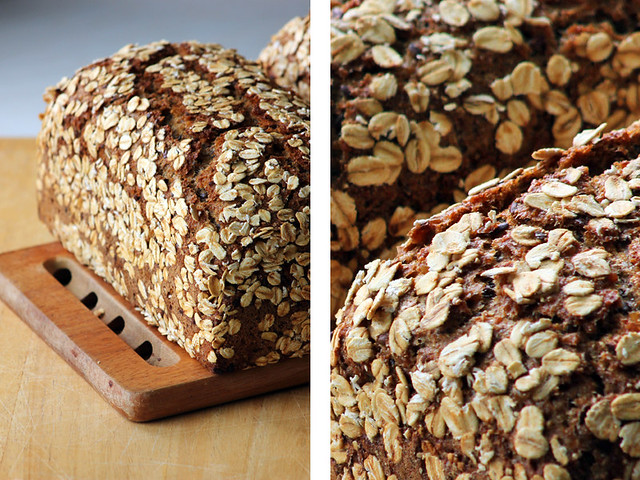 [/url]
[/url]
Formula
Overview | Weight | % |
Total dough weight | 2500g |
|
Total flour | 1390g | 100% |
Total water | 1110g | 80% |
Total salt | 27g | 2% |
Prefermented flour | 278g | 20% |
Desired dough temperature 29°C |
|
|
|
|
|
Starter build – 12 hrs 23°C |
|
|
Starter (Not used in final dough) | 55g | 20% |
Fresh milled rye flour | 278g | 100% |
water | 278g | 100% |
|
|
|
Soaker– 12 hrs 23°C |
|
|
Wheat kibbled | 136g | 28% |
Barley kibbled | 136g | 28% |
Altus (100% rye sourdough) | 136g | 28% |
Linseed | 68g | 14% |
Water | 486g | 100% |
|
|
|
Final dough 29°C |
|
|
Starter | 556g | 88% |
Soaker | 972g | 155% |
Fresh milled rye flour sifted | 343g | 55% |
Fresh milled wheat flour sifted | 281g | 45% |
Water | 343g | 55% |
Salt | 27g | 2% |
Method
- Night before prepare soaker and rye starter.
- Next day autolyse sifted wheat flour and water for one hour, then stir with wooden spoon for 5 minutes.
- Add the rest of the ingredients and mix 5-10mins. I use a scraper in my right hand to pick up and turn the dough and keep my left hand wet enough to avoid excessive sticking.
- Allow bulk ferment for 15-30mins.
- Shape and roll in rolled oats. Place into greased tins (mine were Pullman) seam side down.
- I proved these for one hour before placing into oven with lids on for 10 minutes at 250°C then a further 1.5 hours at 200°C
[url=http://www.flickr.com/photos/67856223@N06/6403734479/] [/url]
[/url]
[url=http://www.flickr.com/photos/67856223@N06/6403737935/] [/url]
[/url]
3 Grain Country Bread mkII
[url=http://www.flickr.com/photos/67856223@N06/6403736523/]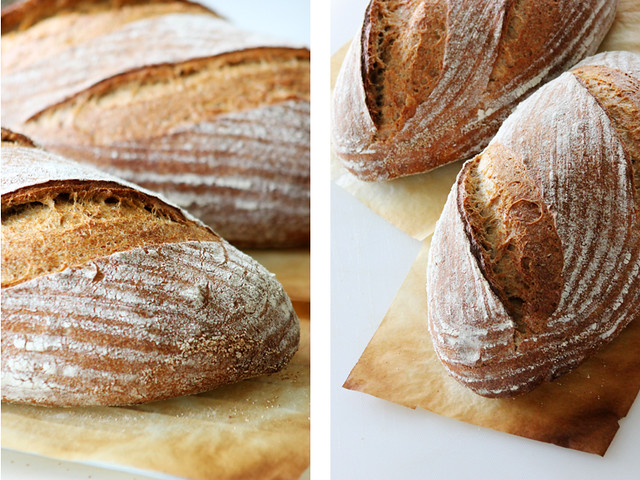 [/url]
[/url]
Formula
Overview | Weight | % |
Total dough weight | 2000g |
|
Total flour | 1111g | 100% |
Total water | 889 | 80% |
Total salt | 22 | 2% |
Prefermented flour | 167g | 15% |
Desired dough temperature 24°C |
|
|
|
|
|
Final dough |
|
|
Rye starter @ 100% hydration | 111g | 12% |
Levain @ 50% Built with 70% AP flour, 18% fresh milled wheat, 9% fresh milled spelt and 3% fresh milled rye + 1% Salt) | 166g | 17% |
Freshly milled wheat flour sifted | 756g | 80% |
Freshly milled wholemeal spelt flour | 189g | 20% |
Water | 778g | 82% |
Salt | 21g | 2% |
Method
- Autolyse flour and water for one hour. (hold back 50 grams of water)
- Add levain and rye starter then knead (French fold) 5-10 mins. Return the dough to a bowl and add salt and 50 grams of water and squeeze through bread to incorporate (dough will separate then come back together smoothly) then knead a further 5-10 mins.
- Bulk ferment three hours (mine was in a cooler bag with icebricks to control rising temps) with three stretch and folds 30min apart in the first 1.5hrs.
- Preshape. Bench rest 20 mins. Shape.
- Final proof was roughly one and a quarter hours at room temperature (27°).
- Bake in steamed oven for 10 mins at 250°C then 30 mins at 200°C
[url=http://www.flickr.com/photos/67856223@N06/6403735469/] [/url]
[/url]
[url=http://www.flickr.com/photos/67856223@N06/6403735965/] [/url]
[/url]
[url=http://www.flickr.com/photos/67856223@N06/6403737041/]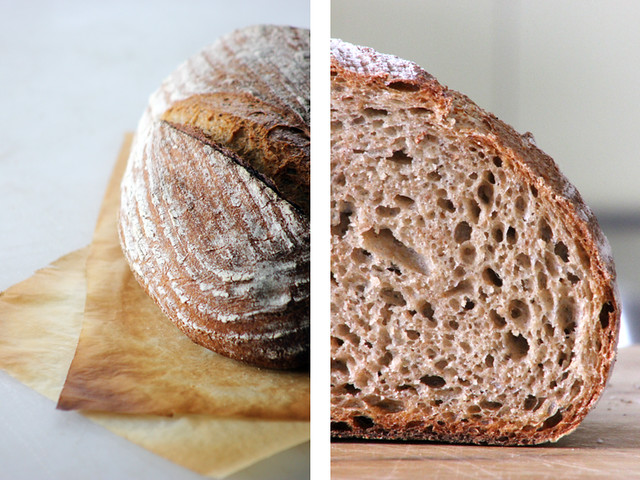 [/url]
[/url]
[url=http://www.flickr.com/photos/67856223@N06/6403737549/]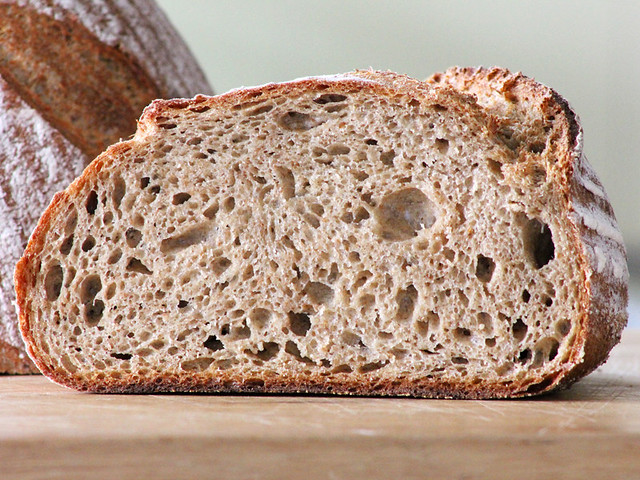 [/url]
[/url]
The kitchen buzzed with activity early this morning. The "Pain de Tradition’s" were taken from the fridge and left at room temperature for an hour before being baked in a dutch oven. Amazing oven spring again with a lot more colour in the crust this time. No crumb shots as these are not for us :)
[url=http://www.flickr.com/photos/67856223@N06/6403733987/]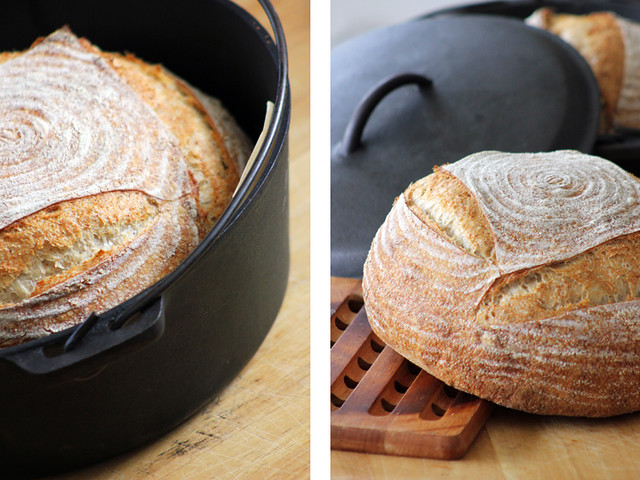 [/url]
[/url]
The "Any Grain Sourdoughs” are always a hit for us and this bake is no different. I am very pleased with the result using entirely fresh milled flour. The flavour is as good if not better than ever (thanks to the altus, rye starter and fresh milled flours) with the crumb being softer than my previous efforts. I love the contrast between the rolled oats and dark caramel crust. These will sustain us during our working week for breakfasts.
Last into the oven today were the “3 Grain Country Breads” These proved extremely quickly as the temperatures rose today. This is my favourite bread. The new levain was evident in the first bite. The bread tasted sweet and I could detect the scent of the new levain. It tasted fresh. A thin crust leads to a crumb that is lighter and softer with the reduced spelt … perfect for kids who enjoyed banana sandwiches on it (they were awesome apparently)
It has rained for the first time this month and as the rain continues softly tonight my new little levain is feeding happily.
All the best,
Phil
- PiPs's Blog
- Log in or register to post comments
Hi Phil,
All your breads are really beautiful...just how many did you bake? If you just have the one oven it must have taken a lot of juggling to create effective production schedule.
Love the rye loaves...well, there's a surprise! I've done a similar trick and rolled the dough in rye flakes before. I suspect oats are better because they will be slightly softer eating texture.
Making a new starter is absolutely the right thing to do. I believe M. Rubaud counsels this as a regular measure in his own work.
Whilst I always maintain a wholemeal rye starter, my wheat culture is maintained solely with white flour. It has that lovely nutty smell you describe...no, I can't quite place it either, but I love it!
Lovely post and lovely bread
All good wishes
Andy
Thanks Andy,
All up there were six loaves. It ran really smoothly. The "Pain de Traditions" warmed on the counter after retarding with the oven preheating while I mixed and autolysed the other breads. They went into the oven as I started mixing. The biggest issue was using the dutch oven. I can only bake one loaf at a time and the "Pain de Traditions" had risen so much that they proved a challenge to load into the pot. By the time they had finished baking I had roughly 15 mins to get the temperature up in the oven before the rye breads were loaded. The Country breads went in last (I can fit two of them in side by side) which gave me some time to heat the oven again ... I need the oven screaming hot for them as I turn it off when I steam it.
We love the rolled oats on the rye breads ... they have a distinct roasted flavour when out of the oven.
You mentioned in your last post about your bread bin being empty ... well we had emptied ours and the freezer as well. These bread are a welcome reprieve.
Good to hear from you.
Phil
Hi Phil, I'm about to attempt your beyond beautiful Any Grain Sourdough bread.
I note the extremely long baking time at fairly high temperature and would appreciate your tips for knowing when the bread is done. Also, do you wrap it in stonething for a prolonged period before cutting? And how do you store it?
I haven't got a pullman pan. Do you advise covering the bread pan?
I've never baked bread with more than 40% rye and I'm getting cold feet.
Patsy
Hi Patsy,
Higher percentage ryes can be a bit intimidating at first. I hope it goes well for you.
I find you get less clues to knowing when a rye breads is baked. A thermometer may be one option and I think Dan gave you some great advice on the forum regarding this.
The amount of grain means the loaf needs a good deal of baking to bake off the moisture so I would keep to the times and temps but try and rotate the loaf around in the oven to ensure even browning.
If you don't have a pullman bread pan you will either need a good steaming setup to apply steam in the initial baking or a way of covering the loaf. I have heard of people using tin foil lids for this or sitting another baking tray on top with something weighing it down. Also a lid stops the top browning to heavily with the prolonged bake.
I don't cut into a loaf before 12 hours ... and 24 is better. I usually store it on a bread board or in a bread bin ... I don't wrap this particular bread.
All the best and please let me know how you go,
Phil
I reposted in the forum because of the time difference between Australia and the West Coast USA. I couldn't hope you could get a reply to me so soon.
I'm currently autolysing the whole wheat, so I'll cover the bread and follow your baking instructions.
Your photos show a most beautiful bread. I hope I can come close.
Patsy
I had no kibbled barley, so I used cracked wheat and substituted barley flour for some of the whole wheat.
Your instruction to put the loaves into the pan 'seam down' caused some minor hilarity. I rigged a covered set-up & baked according to your recipe.
I think I ought to have lengthened the final proof - I saw no rise and got minimal oven spring. The crumb is less open than yours & slightly damp. The crust is scrumptuous - I think I would love crackers made with this dough!
I've never managed to do photos on TFL, sorry.
Very many thanks for your inspiration and assistance.
Patsy
Reading the recipe reminds me I have low blood rye levels! Those wonderful pictures remind me I'm in delirium.
Sniffing starters is addictive (I need a quick whiff to recover, hang on a minute... be right back...) and so wonderful to have a starter that sends your senses reeling! Good going Phil! You know it's right and Oh, the wonderful bread it makes! :)
Doesn't get much better than this!
Thanks Mini,
Your passion for rye breads makes me smile. I keep pushing the levain under Nat's nose for her to smell it ... she will be an addict soon too :)
Cheers, Phil
I think he did.
It's been a while since I watched those wonderful videos on http://www.farine-mc.com/2009/11/meet-baker-gerard-rubaud.html
Beautiful loaves as usual.
You're going to make me buy a mill. I can see it in my future, perhaps right after I sell the panini press.
Thanks thomaschacon,
From what I have read he does quite a few rebuilds. I think he is much more attuned to his levain and its subtleties than I could ever imagine being.
Home milling is a slippery slope ... I can't imagine not having the mill. You just need to plan a few more steps in your baking process :)
mmm ... I could do with a panini press :)
Cheers,
Phil
Phil, I'm deeply impressed by your breads and your obvious baking skills, so perhaps you will entertain a question that is slightly off-topic (but still about the bread). I notice the beautiful snowy tracks that your banneton leaves on the loaves. I have been struggling with different approaches to get the same decorative look. I've been using pure rice flour, which certainly releases the dough nicely, but with "spotty" marks after baking. I tried some rice and rye mixed-- not much difference. I must be missing something obvious. I thought just plain flour would cause the dough to stick.
Could you point me in the right direction? Thanks so much.
Greg
Thanks for the kind words Greg,
I use a 50/50 mixture of rice flour and AP flour. I apply it with a small hand sieve ... this makes for an even and fine application of flour. I flour heavier at the sides as this is were I see most of the sticking.
I also keep the bannetons clean with a small brush after each baking session.
Its a balance to get the right amount to prevent sticking ... if I can tell a particular dough is going to be sticky I will flour heavier or line the basket with a floured tea towel in extreme cases.
Hope this helps ...
All the best,
Phil
Beautiful breads and photos Phil.
I keep my leaven similar to the one you just made. I like the mix GR uses but I found in the summer, with higher temps here, I had to drop the rye from the ingredients. It did slow things down. Your leaven jar rests in a much nicer place than mine does.....Mine is religated to the basement shelving amidst all my kitchen 'over-flows'....
A question about the sifting....I can't help but wonder why, when you have the mill and whole grains that you use, you sift? To me that is where all the nutrition is in the grain and the primary reason that I mill our grains.... Seems to me that you are loosing one of the primary benifits of milling your own grains in the first place?
The only thing I can think of is that you are trying to achieve lighter loaves...Figured I'd better ask and stop my wondering :-)
Take Care,
Janet
Hi Janet,
My levain leads a very nice life ... well loved.
Why do I sift? Yes for lighter bread and cleaner flavour.
Its not that much lighter though ... I am only catching between 5-10% weight of the original grains (my sieve is not super fine). But is enough of a difference that I can see, feel and taste the difference. For me bran is not of primary importance in my bread making. That I can possibly catch as much of the germ and use it fresh makes more of a impact.
I think we make up for the lighter wheat breads with the rye breads we eat :)
When I originally purchased the mill I was making a lot of 100% wheat breads and they are really nice ... Just didn't quite match what I was envisaging my favourite bread to be.
Thanks for the question ...
Good to hear from your,
Phil
Phil,
Makes sense. Some day I may just have to give it a try....but that would require the purchasing of a sieve and my family is already being crowded out of optimum cupboard space with all of my bread baking paraphernalia....just added a DLX mixer to my line-up :-).
Take Care,
Janet
P.S. 'Tis actually nice here being out of our hot summer weather....leavens and doughs much easier to manage with heat sources I can control. (Desk lamp and heating pads....)....not that I am a control freak when it comes to bread......
Hi Phil,
I've been viewing your post on my iPhone during breaks at work today but the little screen just doesn't do these gorgeous breads proper justice. They all look so good, especially now that I've seen them on a large screen, but your Any Grain Sourdough looks amazing! A beautiful moist crumb with a rich dark crust, it's a standout loaf even amongst the other very fine loaves you've made. Great bread, photos and writeup!
Cheers,
Franko
Thanks Franko,
We finished off the last of some frozen Any Grain sourdough during the week and we looked at each other and said we gotta make that again. Maybe its in my head but I am certain it tastes better now with entirely fresh milled grains ... Its a complex flavour.
Cheers, Phil
I echo what fellow TFLers just said, .... Heaps of compliments to your artistic skills, Phil! The any grain bread looks scrumptious!! I have searched all over Dubai for those pullman pans, and the nearest i found was a pullman wannabe, with narrow base !!##@ Grrrr
Back to bread... i was curious as to why you often hold some water at the mixing stage, and add it later.
Thanks!!
I picked up the water tip from the Tartine bread book.
I had held back water in the past so I could better asses the doughs hydration. What was new was adding the held back water with the salt addition.
So I autolyse with out salt, levain and the held back water. I then add the levain and knead for 5mins. Usually to the point that it gets sticky but releases cleanly of the bench. I place the dough back in the bowl and then add the salt and held back water. I love this bit. I squeeze the water and salt through the dough and it comes apart then combines back together. While doing this your fingers become clean and excess dough is cleaned off the bowl. I find it such a clean way of working.
I had to buy my pullman pans online. They are almost impossible to find in shops here.
Cheers,
Phil